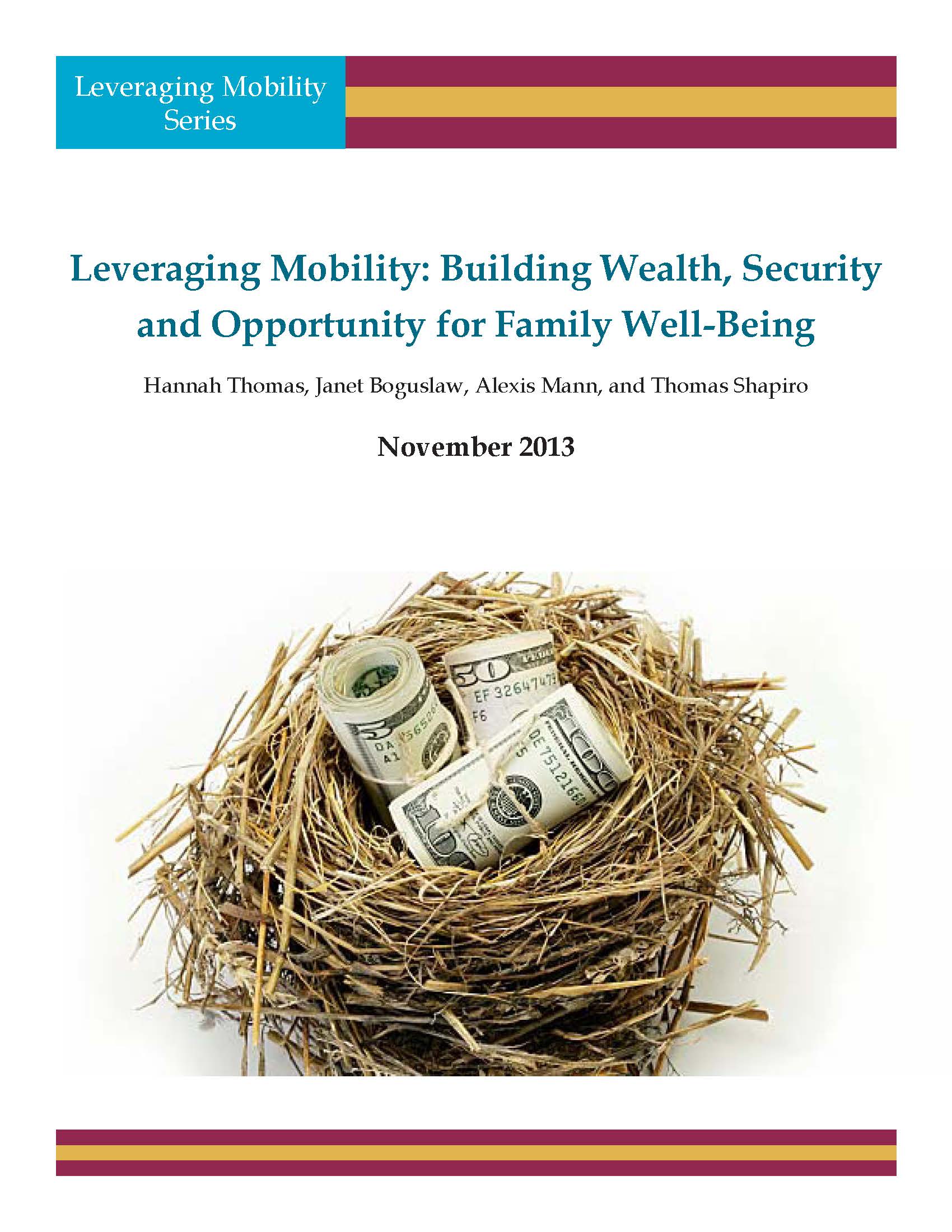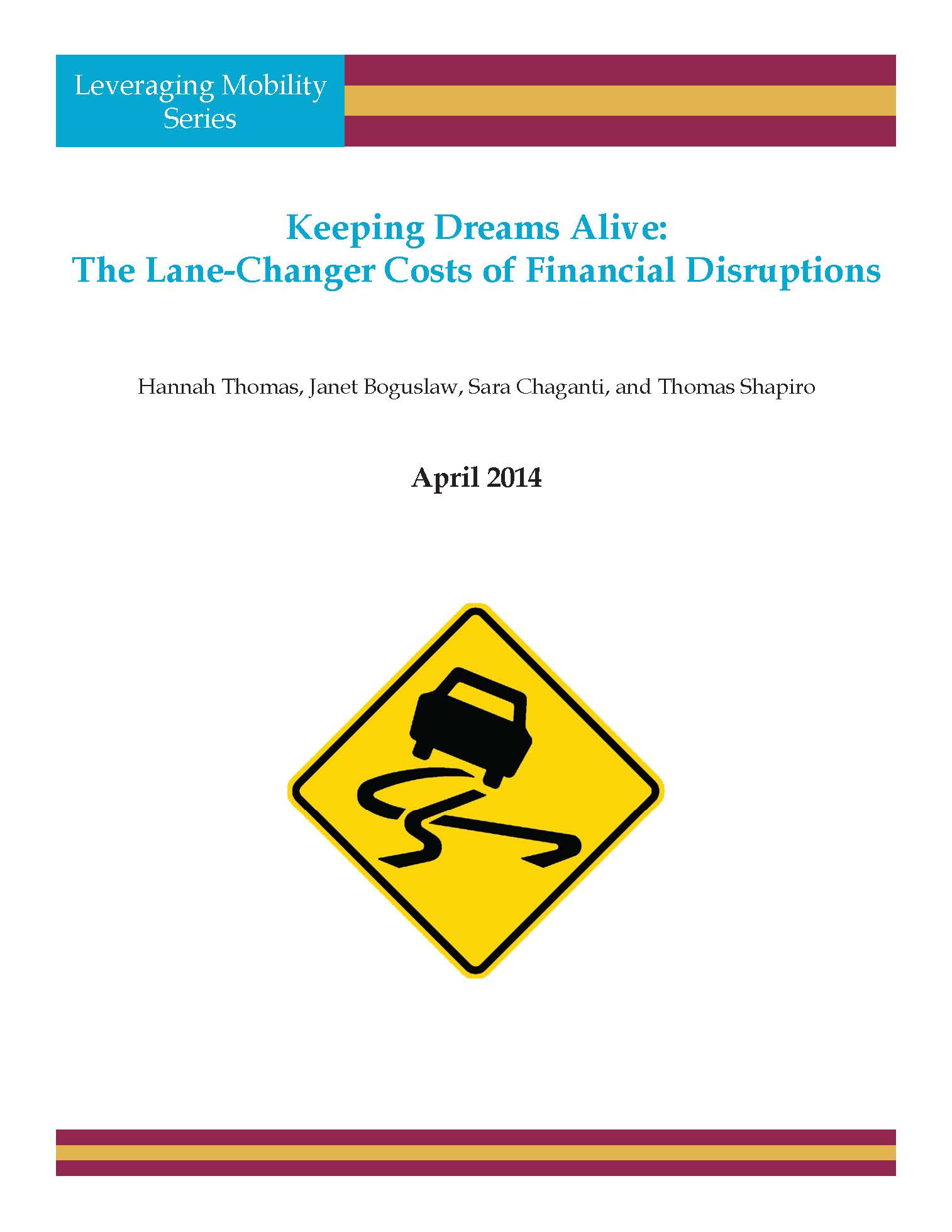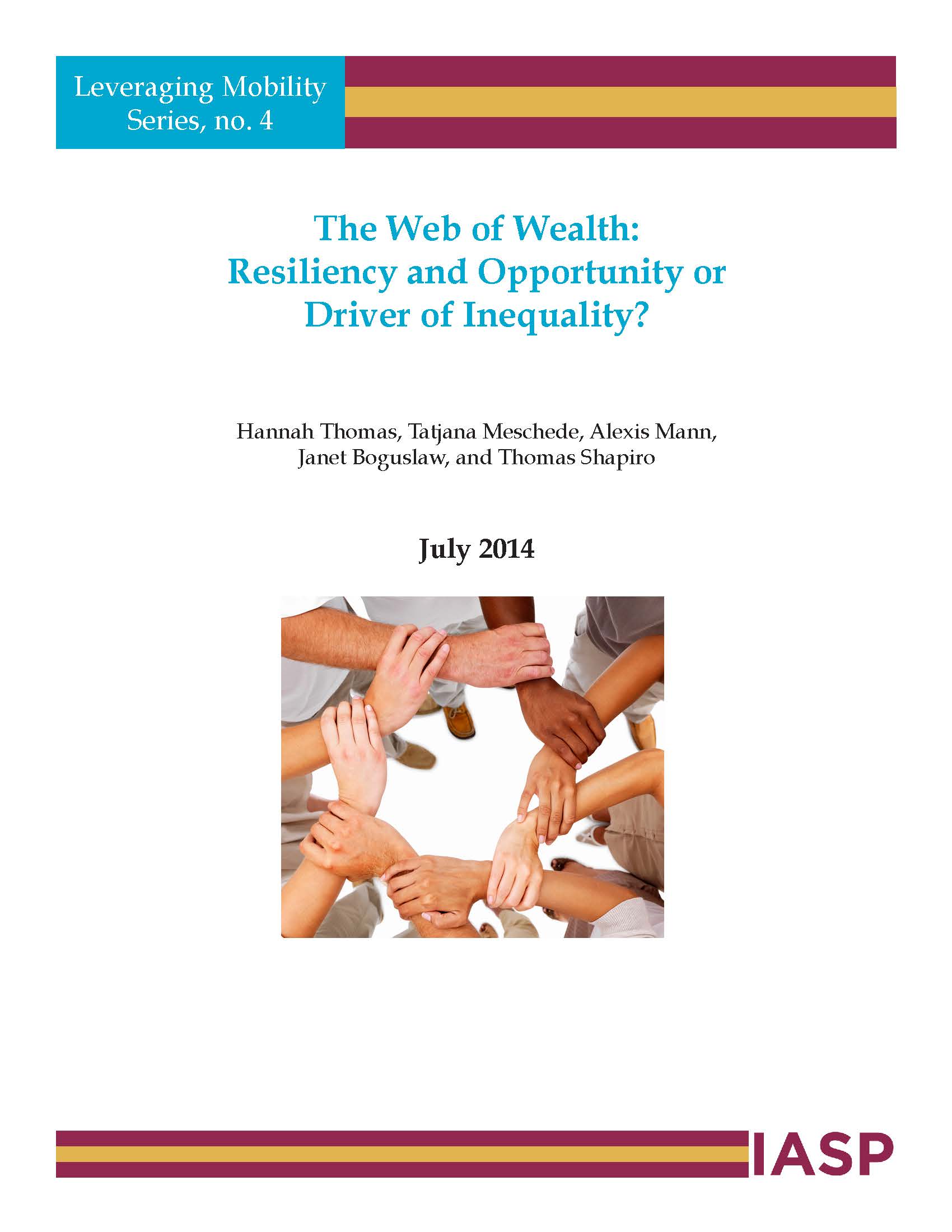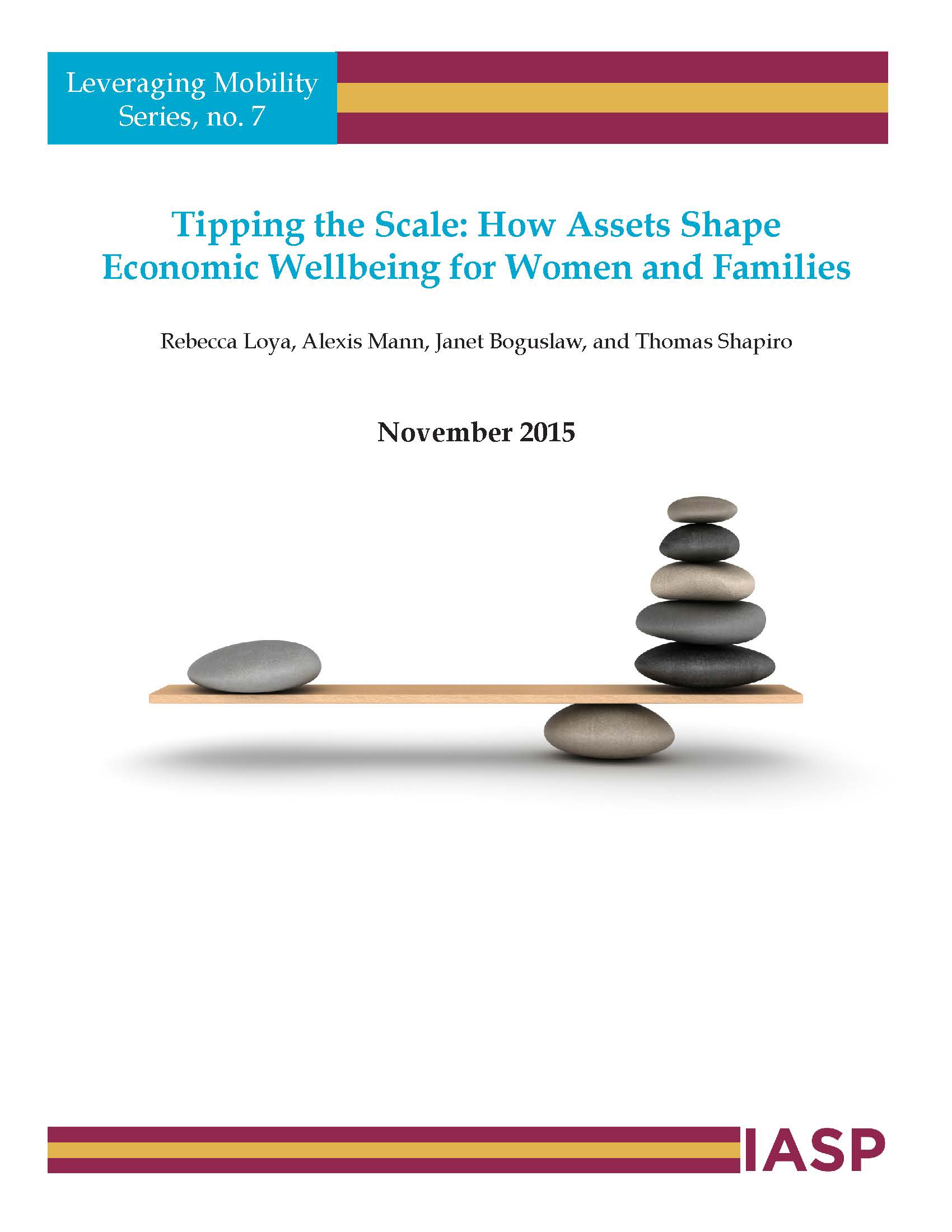The Leveraging Mobility Study Report Series
Bringing together the interview and national survey data raise the question: What has enabled some families to build wealth while others fall behind? These reports in series explore in great depth the choices families face in creating family financial security. It is evident that extended family wealth, policy, and employment structures, and knowledge about and access to reliable information all incentivize an drive the strategies, decisions, and trade-offs that families make. The data point to the intersection of the choices and prospects that families encounter, and the need to create opportunity structures that enable families to access and leverage opportunities to amass wealth and well-being over time.
Each of these research briefs explores analyses results in greater depth.
"Leveraging Mobility: Building Wealth, Security and Opportunity for Family Well-Being"
 The first brief in the Leveraging Mobility series examines how families navigate structural and economic challenges to build and secure wealth. This brief highlights some surprising key findings, and provides information on how families in the study have fared over the first decade of the twenty-first century. In a decade of stagnating economic mobility, and increasing income and wealth inequality, how have families built and secured a nest egg for their own retirement security and to leverage their children’s future well-being? What are the pathways and structures that helped them get on and stay on the wealth escalator? Drawing on a unique dataset of longitudinal interviews conducted twelve years apart, families with children in three major cities across the nation were asked about their assets, wealth, income, economic security and life aspirations.
The first brief in the Leveraging Mobility series examines how families navigate structural and economic challenges to build and secure wealth. This brief highlights some surprising key findings, and provides information on how families in the study have fared over the first decade of the twenty-first century. In a decade of stagnating economic mobility, and increasing income and wealth inequality, how have families built and secured a nest egg for their own retirement security and to leverage their children’s future well-being? What are the pathways and structures that helped them get on and stay on the wealth escalator? Drawing on a unique dataset of longitudinal interviews conducted twelve years apart, families with children in three major cities across the nation were asked about their assets, wealth, income, economic security and life aspirations.
“Employment Capital: How Work Builds and Protects Family Wealth and Security,”
 The second report in the Leveraging Mobility series suggests the link between employment and building wealth goes far beyond the paycheck. Drawing on the lived experiences of families, this report adds a critical new understanding of the connection between work and wealth. Interviewing young families in the late 1990s—when the economy was growing and prosperous—and again in 2010—during a stagnant economy amid dramatic wealth loss—we were surprised to find that more than two-thirds had seen their wealth increase. As we talked to them, it became clear that many factors were at play. One important observation was that for many of the families that built wealth, the characteristics of their employment facilitated a pathway to accumulating wealth that income alone could not provide.
The second report in the Leveraging Mobility series suggests the link between employment and building wealth goes far beyond the paycheck. Drawing on the lived experiences of families, this report adds a critical new understanding of the connection between work and wealth. Interviewing young families in the late 1990s—when the economy was growing and prosperous—and again in 2010—during a stagnant economy amid dramatic wealth loss—we were surprised to find that more than two-thirds had seen their wealth increase. As we talked to them, it became clear that many factors were at play. One important observation was that for many of the families that built wealth, the characteristics of their employment facilitated a pathway to accumulating wealth that income alone could not provide.
A puzzle remained, however. African-American families in our interview sample saw their incomes and educations rise in relation to those of white families, and yet their wealth increased at a significantly lower rate. Sifting through the interview data and aligning it with national data as a comparison, it became clear that wealth-building job characteristics are distributed unequally, and sorted through race, class, and occupation.
"Keeping Dreams Alive: The Lane-Changer Costs of Financial Disruptions"
 Income-disrupting life events–divorce, unemployment, poor health, caregiving–occur far more frequently than we think with real costs and consequences for financial well-being. These life events can have deep consequences that shift life’s trajectories and curtail family-member's dreams.
Income-disrupting life events–divorce, unemployment, poor health, caregiving–occur far more frequently than we think with real costs and consequences for financial well-being. These life events can have deep consequences that shift life’s trajectories and curtail family-member's dreams.
Not everyone experiences the risk of income-disrupting life events equally. Nor do all families have the same depth of resources to navigate them. The result, these life events affect families differently. This Leveraging Mobility series research brief, reviews how families bear the costs of income-disrupting life events and the financial context that impacts how they make decisions to maintain immediate well-being. The third report in the Leveraging Mobility series looks at ways policy can increase the capacity of families to stay on track as well as generate opportunities for families to overcome income-disrupting life events.
"The Web of Wealth: Resiliency and Opportunity or Driver of Inequality?"
 The fourth report in the Leveraging Mobility series seeks to understand the role that extended family wealth networks play. Families often help each other out financially. In the short-term, financial help limits those in the network from economic collapse or a serious decline in their standard of living. Over the long-term, extended family financial support can provide a steppingstone to better opportunities, such as going to college, starting a business, or purchasing a home. Financial transfers can also be much larger, fundamentally changing a family’s lot in life. This network of extended family financial assistance is a “web of wealth” that, in the U.S., profoundly shapes individual family members’ social and economic trajectories beyond their own achievements in work and education. A web of wealth depends on the financial resilience and affluence of its members. Some wealth webs are packed with prosperous individuals. Many family webs have no wealth, especially low-income, African American, and other family of color networks. Across generations, historic policies have contributed to this inequitable wealth distribution. This latest brief in the Leveraging Mobility Series explores these themes in greater depth. It seeks to understand whether extended family wealth networks provide resiliency and opportunity or drive inequality.
The fourth report in the Leveraging Mobility series seeks to understand the role that extended family wealth networks play. Families often help each other out financially. In the short-term, financial help limits those in the network from economic collapse or a serious decline in their standard of living. Over the long-term, extended family financial support can provide a steppingstone to better opportunities, such as going to college, starting a business, or purchasing a home. Financial transfers can also be much larger, fundamentally changing a family’s lot in life. This network of extended family financial assistance is a “web of wealth” that, in the U.S., profoundly shapes individual family members’ social and economic trajectories beyond their own achievements in work and education. A web of wealth depends on the financial resilience and affluence of its members. Some wealth webs are packed with prosperous individuals. Many family webs have no wealth, especially low-income, African American, and other family of color networks. Across generations, historic policies have contributed to this inequitable wealth distribution. This latest brief in the Leveraging Mobility Series explores these themes in greater depth. It seeks to understand whether extended family wealth networks provide resiliency and opportunity or drive inequality.
"Location, Location, Location: The Role Neighborhoods Play in Family Wealth and Well-Being"
 People are drawn to neighborhoods for various reasons—family ties, connections to friends, attachment to institutions—yet, the financial and social resources that a family has access to within these neighborhoods affects a family’s well-being and ability to gain social and economic mobility. In “Location, Location, Location: The Role Neighborhoods Play in Family Wealth and Well-Being”, the fifth report in the Leveraging Mobility series, the Institute on Assets and Social Policy examines the disparities in neighborhood opportunity. This brief delineates between high opportunity and low opportunity neighborhoods, explains the disparities in neighborhood opportunity and reveals the reasons why families are sorted by race and class into different quality neighborhoods.
People are drawn to neighborhoods for various reasons—family ties, connections to friends, attachment to institutions—yet, the financial and social resources that a family has access to within these neighborhoods affects a family’s well-being and ability to gain social and economic mobility. In “Location, Location, Location: The Role Neighborhoods Play in Family Wealth and Well-Being”, the fifth report in the Leveraging Mobility series, the Institute on Assets and Social Policy examines the disparities in neighborhood opportunity. This brief delineates between high opportunity and low opportunity neighborhoods, explains the disparities in neighborhood opportunity and reveals the reasons why families are sorted by race and class into different quality neighborhoods.
Drawing on longitudinal survey and interview data, this brief seeks to understand how families negotiate the diverse structure of neighborhood opportunity and explores their experiences of living in different types of neighborhoods. National-level longitudinal quantitative data illustrates the consequences of where a family lives and highlights why families place so much emphasis on gaining access to the “right” neighborhood.
The history of racial segregation in the United States has laid the foundation for ongoing neighborhood opportunity segregation. Policy has helped structure the segregation of opportunity by race and class, and so policy clearly has a critical role to play in helping to create a fairer distribution of opportunity by neighborhood.
The history of racial segregation in the United States has laid the foundation for ongoing neighborhood opportunity segregation. Policy has helped structure the segregation of opportunity by race and class, and so policy clearly has a critical role to play in helping to create a fairer distribution of opportunity by neighborhood.
"Navigating an Unclear Path: Preparing for Retirement in the 21st Century"
 All families hope for lasting financial security, but today many families in the United States struggle to make ends meet, let alone prepare for their financial future. In the sixth brief in the Leveraging Mobility series, “Navigating an Unclear Path: Preparing for Retirement in the 21st Century”, a mixed-methods approach is taken to analyze the long-term financial well-being of middle-aged households as they plan for the future and approach retirement.
All families hope for lasting financial security, but today many families in the United States struggle to make ends meet, let alone prepare for their financial future. In the sixth brief in the Leveraging Mobility series, “Navigating an Unclear Path: Preparing for Retirement in the 21st Century”, a mixed-methods approach is taken to analyze the long-term financial well-being of middle-aged households as they plan for the future and approach retirement.
Notably this research suggests that establishing a secure, long-term financial position does not occur in a vacuum. Instead, neighborhood and family resources, as well as institutional setting, are key resources in creating a financial foundation for a family. By understanding the sources of security and the key vulnerabilities families face, policy can be proposed and structural solutions suggested that expand long-term later life security to a greater numbers of families.
"Tipping the Scale: How Assets Shape Economic Wellbeing for Women and Families"
 Caregiving responsibilities and changes in household composition, such as divorce or separation, create financial challenges that disproportionately affect women. The seventh brief in the Leveraging Mobility series, “Tipping the Scale: How Assets Shape Economic Wellbeing for Women and Families,” examines how families leverage neighborhood, institutional, and personal resources to protect against these gendered, wealth-stripping forces. Framed by national trends that point to racial disparities in access to these resources, the brief uses comparative case studies to explore how unequal access shapes the set of strategies and trade-offs available to women and their families.
Caregiving responsibilities and changes in household composition, such as divorce or separation, create financial challenges that disproportionately affect women. The seventh brief in the Leveraging Mobility series, “Tipping the Scale: How Assets Shape Economic Wellbeing for Women and Families,” examines how families leverage neighborhood, institutional, and personal resources to protect against these gendered, wealth-stripping forces. Framed by national trends that point to racial disparities in access to these resources, the brief uses comparative case studies to explore how unequal access shapes the set of strategies and trade-offs available to women and their families.








